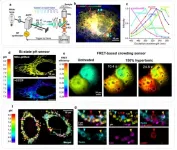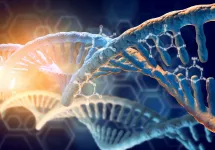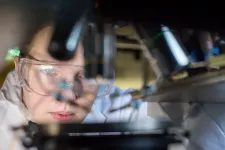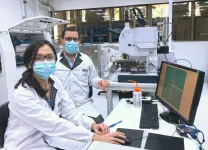Computer designs magnonic devices
2021-05-12
(Press-News.org) The field of magnonics offers a new type of low-power information processing, in which magnons, the quanta of spin waves, carry and process data instead of electrons. The end goal of this field is to create magnonic circuits, which would be smaller and more energy-efficient than current electronic ones.
Until recently, the development of a functional magnonic device could take years of trial-and-error. Researchers from the University of Vienna and the TU Kaiserslautern have developed a new computational method to design new devices in a considerably shorter time. Moreover, the efficiency added through this novel inverse design method helps overcome a traditional problem with such devices: they were just suitable for one function only. Now, thanks to the proposed new concept, a primary device could, in principle, be easily modified to perform any function.
Qi Wang, the first author of the study published in Nature Communications, suggested adopting a method that had been used in the field of photonics to magnonics, where the approach has proven to work even better. Three basic principles help to explain the process, as is shown in the figure. First the researchers decide on the functionalities of the device they want to design e.g. a Y-circulator, one of the most common components for separating signal directions in systems engineering. This device guides spin waves from one port into another port according to the circulation condition: wave from port 1 should go into port 2, wave from port 2 into port 3 and from port 3 into port 1. Second, this "task" is translated into a computer language. Finally, the computer generates random structures and optimizes them step-by-step to reach the required functionality. This trial-and-error process is carried out at a very high speed and attains the best solution thanks to an intelligent algorithm. The end result is a design of a working device with the functionalities envisaged by the researchers. This, as Wang from the University of Vienna puts it: "[...] opens the door to large scale magnonic integrated circuits, with any functionality and a high level of complexity".
The proposed approach overcomes the hurdle of designing through experimentation and, instead, emphasizes the importance of researchers' imagination, who fix the parameters and objectives for the computer-designed devices. An example of this creative process comes from Philipp Pirro, scientist at the TU Kaiserslautern: "With inverse-design one could develop neurons like the ones in our brain, but made out of magnonic elements instead."
The excitement about the possibilities of this approach comes from its capacity to create different functionalities. In their article, the scientists describe how they created a set of different devices. Thus, besides the mentioned Y-circulator, they realized a "multiplexer" that separates a wave with a specific frequency into one channel and a wave of another frequency into another channel. This kind of devices is used in our everyday life to get fast internet. The final demonstrated device is a "non-linear switch" that separates spin waves of different energies: it sends a wave of low power to one output and a wave of high power to another. However, Andrii Chumak, head of the research group at the University of Vienna, points out: "Our study opens the new field of inversed design magnonics with great perspectives. This approach, for now, has been demonstrated numerically only. The next big challenge is to implement it in experiments."
Reflecting on the potential of their findings, Qi Wang jokes: "If I would have had the inverse design approach at the beginning of my studies, I would have finished my PhD way faster!"
INFORMATION:
Publication in Nature Communications: Q. Wang, A.V. Chumak, P. Pirro, "Inverse-design magnonic device", Nat. Comm. (2021), DOI: 10.1038/s41467-021-22897-4
[Attachments] See images for this press release:

ELSE PRESS RELEASES FROM THIS DATE:
2021-05-12
The inhibition of pathological protein-protein interactions is a promising approach for treating a large number of diseases, including many forms of cancer. A team of researchers has now developed a bicyclic peptide that binds to beta-catenin--a protein associated with certain types of tumor. The secret of their success is the cyclic nature and the hairpin shape of the peptide, which mimics a natural protein structure, they report in the journal Angewandte Chemie.
Because of the extensive protein regions involved in protein-protein interactions, therapeutic approaches involving small molecules are often unsuccessful. Protein mimetics are alternatives that imitate the spatial structure of binding segments of natural protein binding partners. ...
2021-05-12
In a new study from Lund University and the University of Gothenburg, patients were interviewed about their experiences ten years after undergoing obesity surgery. The results show that the effect on eating and weight regulation persisted, whereas other problems, such as feelings of guilt about still not being healthy enough, remained.
"This is one of few follow-ups from a patients perspective so long after surgery", says My Engström, researcher in nursing at the University of Gothenburg.
18 patients were interviewed in the study. All of them experienced that their eating habits and appetite were still affected after the operation: their bodies still objected, preventing ...
2021-05-12
Mycobacterium tuberculosis is incredible in that it can survive for decades within its human host. It does this by varying its diet to successfully steal nutrients from the human host including immune cells; it is known to acquire and absorb multiple carbon sources from the body during infection.
In a paper published in the journal Molecular Systems Biology, Surrey scientists detail how they measure the flow of metabolites or "fluxes" through metabolic pathways when Mycobacterium tuberculosis is consuming some of its favourite nutrients. Measuring these 'fluxes' could help scientists advance new tuberculosis drugs as well as understand why the bacterium survives so long in humans and why current antibiotics are often ineffective.
By growing Mycobacterium ...
2021-05-12
The multiplexing capability of fluorescence microscopy is severely limited by the broad fluorescence spectral width. Spectral imaging offers potential solutions, yet typical approaches to disperse the local emission spectra notably impede the attainable throughput and place substantial constraints on temporal resolution. Tunable bandpass filters provide a possibility to scan through the emission wavelength in the wide field. However, applying narrow bandpasses to the fluorescence emission results in inefficient use of the scarce signal.
In a new paper published in Light: Science & Application, a team of scientists, led by Professor Ke Xu ...
2021-05-12
The DNA sequences produced are also called oligonucleotides. These are widely used for disease identification, for the manufacture of oligonucleotide-based drugs, and for several other medical and biotechnological applications.
The high demand for oligonucleotides therefore requires an efficient automated method for their chemical production.This process relies on phosphoramidites, which are chemical compounds that have the disadvantage of being unstable unless stored at the ideal -20 degrees Celsius.
Instruments used for DNA synthesis are not able to cool down the phosphoramidites, and consequently it is unavoidable that some of them degrade after being added ...
2021-05-12
"We're meant to be crossing over ... but the bridge is broken": 2020 university graduates' experiences of the pandemic in Ireland
A new study from Trinity College Dublin investigating the impact of the COVID pandemic on young adults finds that they are vastly more affected than older people, and the reverberations of the disruption to some will last decades. Researchers say this group have paid a high price in the form of foregone opportunities for education, social networks, and labour market integration.
The research, involving university graduates in Ireland, is published in YOUNG: ...
2021-05-12
A researcher at University of Limerick has developed a low-cost, environmentally friendly sensor that can detect damage in pipelines and could save water as a result.
The damage detection sensor uses highly sensitive, eco-friendly crystals that generate an electrical signal in response to a leak.
It is the first validation of these biological crystals for real world applications, according to Dr Sarah Guerin, a postdoctoral researcher at the Department of Physics and the Bernal Institute in UL, who has been developing amino acid crystal devices since 2017.
An Irish research collaboration between the Bernal Institute at UL and the Dynamical Systems and Risk Laboratory in University College Dublin has validated ...
2021-05-12
In mathematics, simple equations can generate a complex evolution in time and intriguing patterns in space. One famous example of this is the Mandelbrot set, named after the French-American mathematician of Polish origin, Benoit B. Mandelbrot (1924-2010), the most studied fractal. This set is based on a single quadratic equation with only one parameter and one variable. The fascinating fractal patterns of the Mandelbrot set have attracted attention far beyond mathematics.
An article by Ralph Andrzejak, entitled "Chimeras confined by fractal boundaries in the complex plane", forms part of a special edition of the journal Chaos in memory of Russian professor Vadim S. Anishchenko, (1943-2020), published on 3 May 2021. Andrzejak is head of the Nonlinear Time Series Analysis Group ...
2021-05-12
Intelligent materials, the latest revolution in the field of materials science, can adapt their properties depending on changes in their surroundings. They can be used in everything from self-healing mobile phone screens, to shape-shifting aeroplane wings, and targeted drug delivery. Delivering drugs to a specific target inside the body using intelligent materials is particularly important for diseases like cancer, as the smart material only releases the drug payload when it detects the presence of a cancer cell, leaving the healthy cells unharmed.
Now, researchers from the Centre ...
2021-05-12
Researchers at the Francis Crick Institute and the Latvian Institute of Organic Synthesis have designed a drug-like compound which effectively blocks a critical step in the malaria parasite life cycle and are working to develop this compound into a potential first of its kind malaria treatment.
While drugs and mosquito control have reduced levels of malaria over recent decades, the parasite still kills over 400,000 people every year, infecting many more. Worryingly, it has now developed resistance to many existing antimalarial drugs, meaning new treatments that work in different ways are urgently needed.
In their research, published in PNAS, the scientists developed a set of compounds designed to stop the parasite being able to burst out of red ...
LAST 30 PRESS RELEASES:
[Press-News.org] Computer designs magnonic devices




